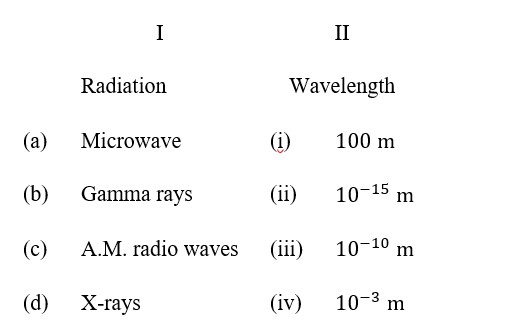Electromagnetic Waves
Get insights from 92 questions on Electromagnetic Waves, answered by students, alumni, and experts. You may also ask and answer any question you like about Electromagnetic Waves
Follow Ask QuestionQuestions
Discussions
Active Users
Followers
New answer posted
2 months agoContributor-Level 10
I=½ε? E? ²c ⇒ E? =√ (2I/ε? c)
Erms = E? /√2 = √ (I/ε? c) = √ (315/π / (8.86e-12 * 3e8) = 194
New answer posted
3 months agoContributor-Level 10
x = 1/√ (µ? ε? ) = speed ⇒ [x] = [L¹T? ¹]
y = E/B = speed ⇒ [y] = [L¹T? ¹]
z = l/ (RC) = l/τ ⇒ [z] = [L¹T? ¹]
So, x, y, z all have the same dimensions.
New answer posted
3 months agoContributor-Level 10
Energies of given Radiation can have
The following relation
Eγ-Rays > EX-Rays > Emicrowave > EAM Radiowaves
∴ λγ-Rays < X-Rays < microwave < AM Radiowaves
According to tres.
(a) Microwave → 10? ³ m
(b) Gamma Rays → 10? ¹? m (ii)
(c) AM Radio wve → 100 m (i)
(d) X-Rays → 10? ¹? m
New answer posted
3 months agoContributor-Level 10
(A) Source of microwave frequency => Magnetron
(B) Source of infrared frequency =>Vibration of atoms and molecules
(C) Source of Gamma rays => Radioactive decay of nucleus
(D) Source of x-rays => inner shell electrons.
Taking an Exam? Selecting a College?
Get authentic answers from experts, students and alumni that you won't find anywhere else
Sign Up on ShikshaOn Shiksha, get access to
- 65k Colleges
- 1.2k Exams
- 679k Reviews
- 1800k Answers

